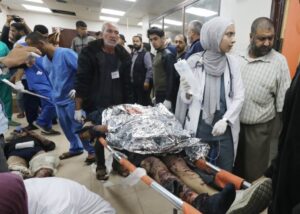Rotting wounds, starvation, babies born in tents without anesthesia, the spread of infectious disease, and the severe lack of medicine are all part of the new normal for over two million people living in Gaza.
Last week, the Gaza-based Palestinian health ministry said that about 600,000 people in the northern Gaza Strip no longer have access to any kind of healthcare. It also warned that medicine fridges and the only oxygen plant in Gaza are at risk of shutting down due to the systematic lack of fuel. The World Health Organization has said that Israel is “systematically dismantling” the health system in Gaza. Save The Children has reported that Israel’s attacks on the health sector in Gaza have been higher than in any other conflict — at the rate of 73 attacks per day.
But one of the most major blows that Gaza’s health system suffered was in early April, following a two-week Israeli siege of al-Shifa Hospital, leaving the medical compound completely and permanently non-operational. The aftermath of the siege revealed that a massacre had occurred. Mondoweiss gathered testimonies from survivors of how it was carried out by Israeli soldiers, which included rounding up people in the hospital, separating them into groups identified by differently-colored bracelets, and executing one of the groups before burying them in mass graves.
Al-Shifa was the largest Palestinian medical complex in all of historic Palestine. Founded under the British Mandate in 1946, it grew over the years until it became the Gaza Strip’s primary medical hub, housing 25% of its medical staff. It was the beating heart of Gaza’s health system.
“Al-Shifa was the center of all medical services in the Strip. It was the ultimate destination for complex medical conditions,” Nebal Farsakh, a spokesperson for the Palestinian Red Crescent Society (PRCS), told Mondoweiss. “It was also the training center of a large number of medical students and practicing junior doctors.”
“During previous wars, al-Shifa was a hub for receiving complicated injuries and the overload from other hospitals, as it had the most complete equipment and a wide range of specialized doctors in most medical fields,” Farsakh added. “Yet, al-Shifa was repeatedly overwhelmed during the Israeli assaults of 2008 and 2014, which were much shorter and caused much less casualties than the current assault.”
“My 19-year-old cousin, Anas Abu Rass, lost his leg after bomb shrapnel hit him while he was sleeping in his bedroom,” Huda Amer, a resident of Gaza City who continues to live there with her family, told Mondoweiss. “For this critical wound, in normal conditions, we would have taken him to al-Shifa. Now he is being treated in a small primary health care center where they don’t have the equipment, and they had to amputate his leg.”
“Most patients who have scheduled surgeries on the public health insurance list were treated at al-Shifa. Now, they are all waiting their turn in the remaining overcrowded hospitals and getting whatever help they can in small clinics, like my cousin,” she added.
The second largest hospital in the Strip after al-Shifa was the Nasser Hospital in Khan Younis. Israeli forces besieged the hospital for weeks at a time between February and April, targeting Palestinians inside with sniper fire. In mid-February, Israeli forces raided the hospital and forced medical staff and patients alike to leave its premises, arresting hundreds.
The Israeli army withdrew from Khan Younis in early April. After the withdrawal, Palestinians found hundreds of bodies buried in mass graves in the hospital’s vicinity, a repeat of al-Shifa. Many of the bodies unearthed from the scene had medical catheters still attached to their bodies, indicating that they had been patients. Others were found with their hands bound by zip-ties with Hebrew labels on them. Mondoweiss gathered testimonies from people who visited the mass graves searching for missing relatives who had disappeared months earlier. Some were able to identify them and put the mystery of their disappearance to rest. Others were not quite so lucky and were left wondering about the fate of their loved ones.

